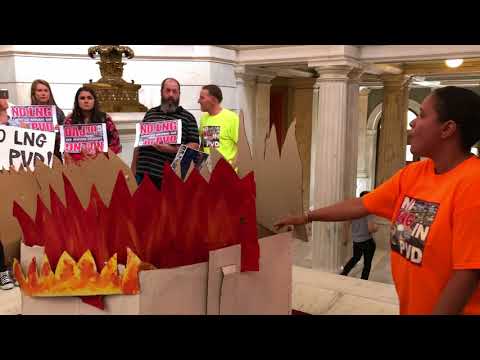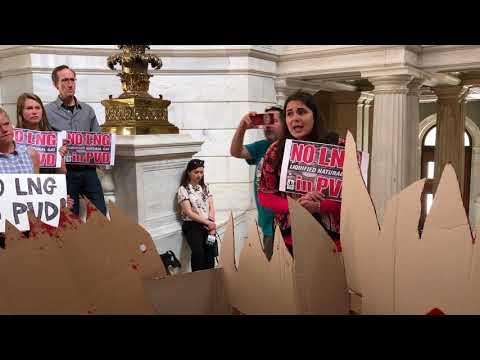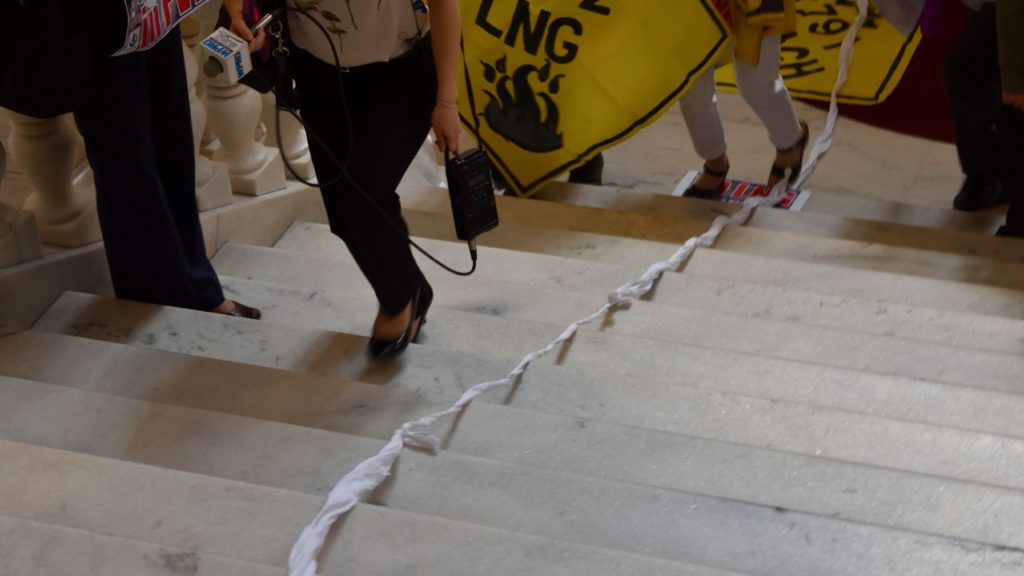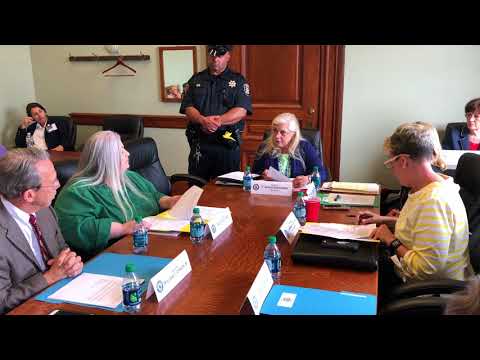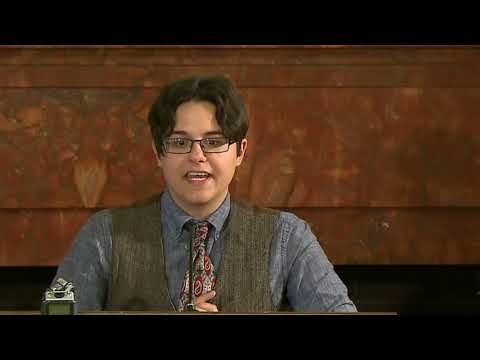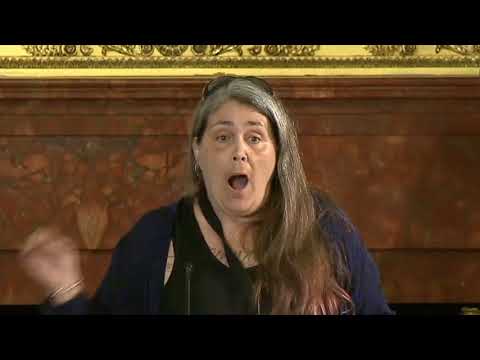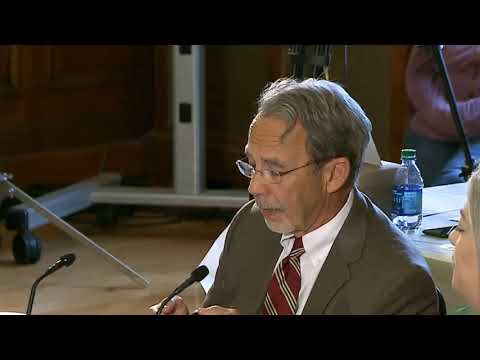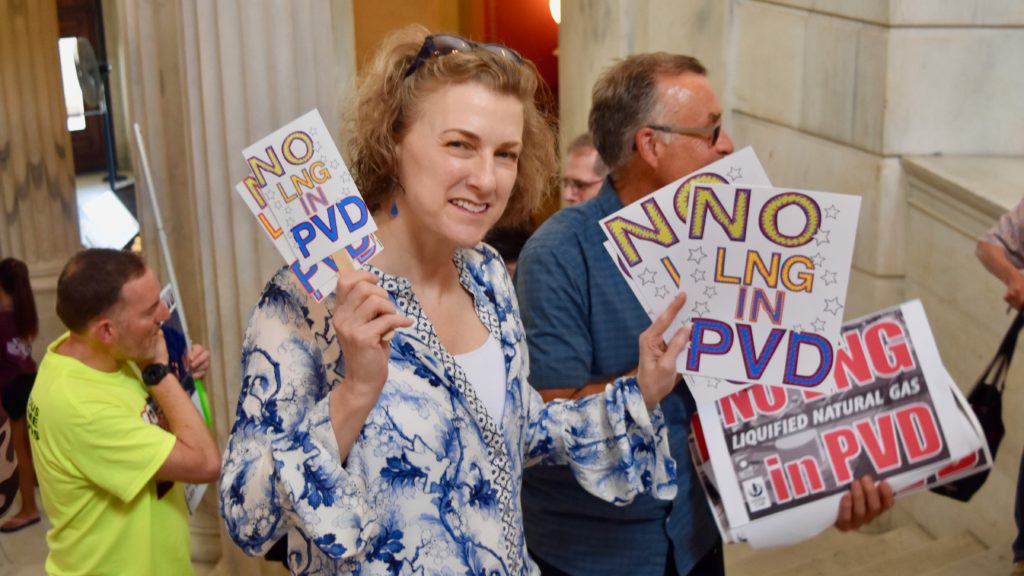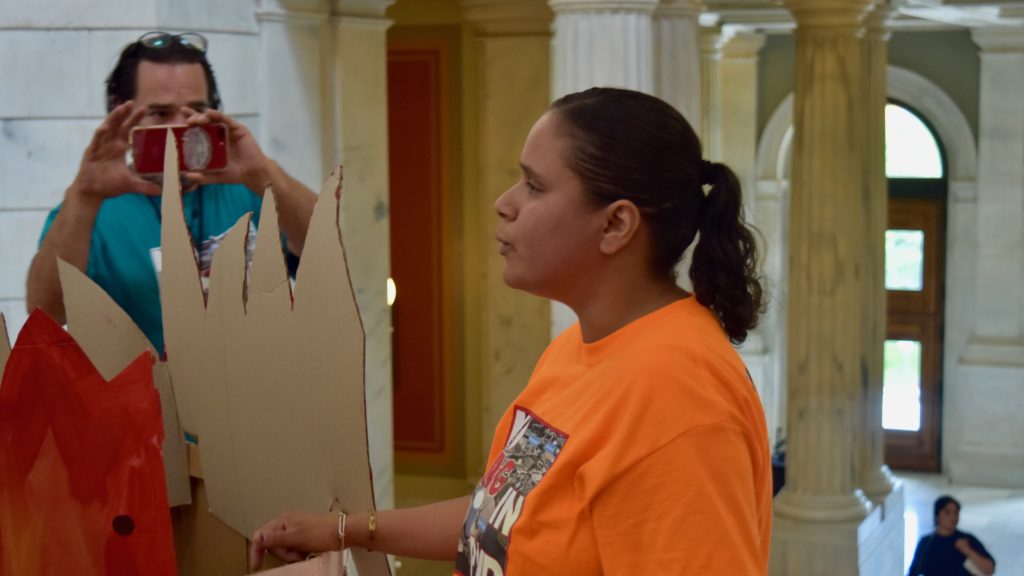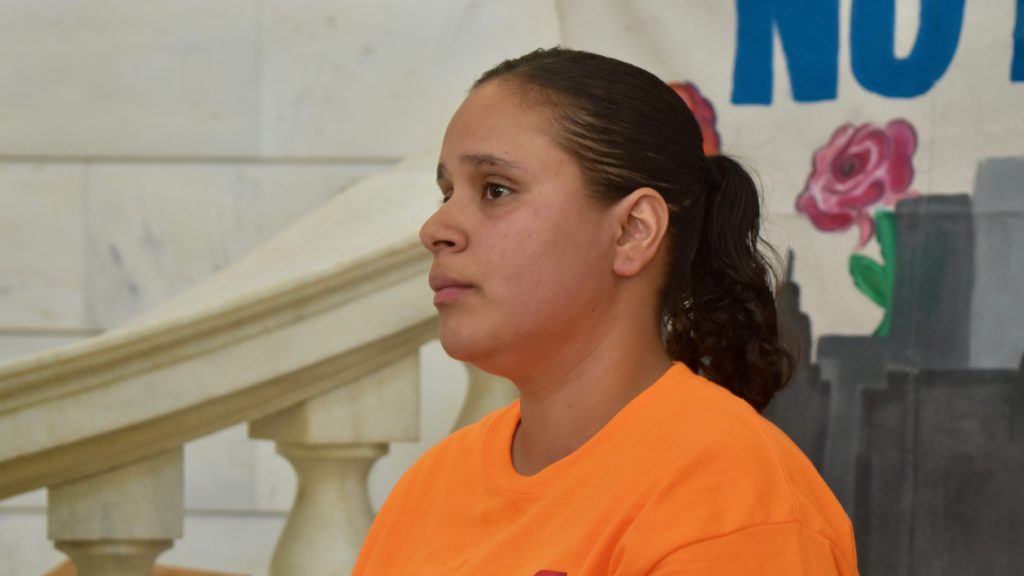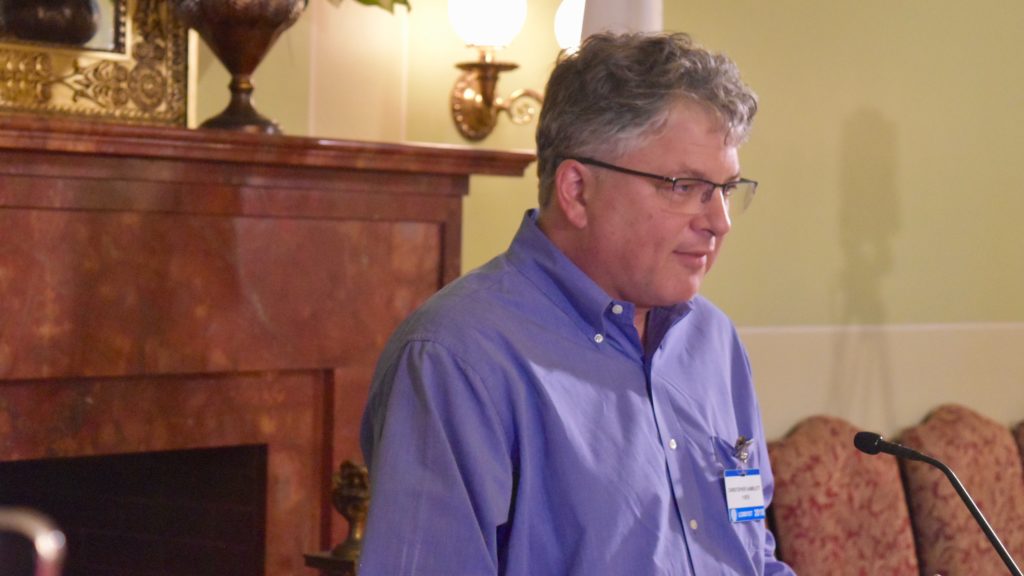No LNG in PVD! floods the State House
Monica Huertas, campaign coordinator of No LNG in PVD! led a “Flood the State House” event where nearly seventy people called on Governor Gina Raimondo to take action against the environmental racism and for the health and safety of nearby Washington Park residents. At issue is National Grid‘s proposed liquefaction facility, which was approved by the Coastal Resources Management Council
June 7, 2018, 12:31 pm
By Steve Ahlquist
Monica Huertas, campaign coordinator of No LNG in PVD! led a “Flood the State House” event where nearly seventy people called on Governor Gina Raimondo to take action against the environmental racism and for the health and safety of nearby Washington Park residents.
At issue is National Grid‘s proposed liquefaction facility, which was approved by the Coastal Resources Management Council (CRMC) after Governor Raimondo switched out council members, including the council chair, ahead of a key vote. Those council meetings were contentious and more than tinged with racism.
Coincidentally, the Senate Committee on Environment and Agriculture scheduled the re-appointment of three members of the CRMC for the same afternoon as the No LNG in PVD! event, so the protest moved from the State House rotunda, to the Senate Committee hearing in room 211.
But before moving, Huertas brought a cardboard LNG tank and decorated the top with cardboard fire to demonstrate the worst case scenario residents face living near the Porrt.
“We need to stop Gina Raimondo and National Greed from building this $180 million [liquefaction facility] in the Port of Providence,” said Huertas. “The tank was built to last thirty years, and it’s already thirty years old.”
Huertas listed two near disaster in the Port, including the derailment of an ethanol bomb train and a fracked gas pipeline explosion last year that occurred mere weeks apart.
“We are not dispensable,” said Huertas. “Shame on you Gina!”
Below is full coverage of the rally and the Senate Committee Meeting:
Aaron Jaehnig of the Sierra Club spoke:
Nicole Dipaolo from Climate Action Rhode Island:
Shannon Donahue:
Democratic Candidate for Governor Matt Brown:
Democratic Candidate for Governor Paul Roselli:
After the rally in the State House rotunda, the group moved to room 211, where the Senate Committee on Environment and Agriculture was soon going to decide on three re-appointments to the Coastal Resources Management Council (CRMC). No LNG in PVD! unfurled a “pipeline,” a length of knotted cloth, from the rotunda to room 211.
“Follow the pipeline!” said Huertas. “Let’s see how they like it when there are pipelines going through their neighbor hoods.”
The “pipeline” was quickly balled up and kicked aside by Capitol Police. After all, pipelines are dangerous.
As protesters arrived at room 211, Senator Frank Lombardi (Democrat, District 26, Cranston) organized a police detail. This is a common reaction to No LNG in PVD! and all groups representing the poor and people of color who advocate on their own behalf in public spaces.
They are policed.
People were not in the room for long, and the meeting had yet to begin, when the Senate Parliamentarian informed Committee Chair Senator Susan Sosnowski (Democrat, District 37, Block Island, South Kingstown) that no signs were allowed in the room. Sosnowski dutifully told the crowd to leave the room with their signs or put their signs away.
“Okay everyone,” said Sosnowski, a large police officer by her side acting as an exclamation point. “The Parliamentarian of the Senate has just given a ruling: No signs in the committee room. I’m sorry.”
“God forbid any signs…” said protester Sally Mendzella.
“We already read them,” retorted Sosnowski. “The message has been made but the signs have to come down. I thank you for coming and you’re all welcome to stay, just no signs.”
“At ten of five the clerk called the minority office,” said Sosnowski to the committee members. “And our legal counsel has said that we have to wait fifteen minutes and then we can proceed.” After 15 minutes, if no one from the minority party arrives, “we can move forward,” said Sosnowski.
The absence of any member of the minority party, aka Republicans, in the room is a direct result of my story about Senator Dennis Algiere (Republican, District 38, Westerly, Charlestown) falsifying his presence at a previous meeting.
“…there are only four Republicans in the Senate, and they need to be at the numerous hearings and other commitments all taking place at around the same time. Leader Algiere, as an ex-officio member of all committees, checks in to enable the committees to proceed,” said Greg Pare, director of communications for the Senate President in response to my query.
Of course, Algiere could actually attend a meeting of the House Committee on Environment and Agriculture, thereby alleviating the need to either delay the meeting 15 minutes or pretend to be there when he is not, but that seems unlikely.
So we waited for 15 minutes.
Chants of “No LNG in PVD!” filled the hallways outside the committee meeting room.
After the required 15 minute wait, Senator Sosnowski called the meeting to order and announced that the meeting was to be moved to a larger room, the Senate Lounge. Everyone moved. The event was also going to have microphones, be recorded and be televised.
After arriving en masse in the Senate Lounge, Chair Sosnowski called the meeting to order. She began by announcing the purpose of the meeting, the re-appointment of CRMC members Donald Gomez, Michael Hudner and Patricia Reynolds. Sosnowski noted that the re-appointments had been delayed due to the letter from No LNG in PVD! (see here).
Sosnowski then read a letter from Claire Richards, legal Counsel for Governor Raimondo, who made the argument that No LNG in PVD!’s legal arguments were invalid, or fell under the Senate’s role of offering “advice and consent” on gubernatorial nominees. (You can access the Governor’s letter here and here.)
The entirety of No LNG in PVD!’s arguments as to the systemic and environmental racism implicit in the board’s make-up and actions during hearings on National Grid’s proposed liquefaction facility, were ignored in the letter from the Governor’s legal counsel, and left to the discretion of the Senate Committee, who, as you will see below, punted. (For a rundown on some of the background and links to ALL of the background on these issues, see here and here.)
Sosnowski also noted the Save The Bay lawsuit over the Governor’s ability to nominate council members to the CRMC, given that the governor had already placed more people on the board than she was allowed to under the law.
Senate legal counsel agreed with the Governor’s legal counsel, so Sosnowski felt free to hold a hearing and ultimately call for the approval of the three re-appointments.
Testimony was heard from the public.
Sosnowski made it clear that the testimony to be heard by the committee was to be focused very narrowly. She was interested in hearing about the three re-appointments, and said that all comments about the legislation that would possibly change the law regarding the make-up of the CRMC would be heard at a separate meeting the next day.
This proved problematic, as the two issues are intertwined, but it is a common tactic for those in power to limit testimony by focusing on minor procedural nuances. This destroys the public’s ability to make larger arguments about systemicc issues.
The first member of the public to testify, Lorraine Savard, was completely shut down. She wanted to speak on the legislation that would allow the Governor more power over the CRMC, and the re-appointments should have allowed a route into that subject, but Sosnowski interrupted Savard, and Savard was silenced.
“Just to remind everybody we are talking on the appointees, not on CRMC, but on the appointees process,” said Sosnowski just before the second member of the public was to testify.
How is one to separate the appointees from the job they are being appointed to?
Nicole Dipaolo found herself interrupted by Sosnowski for going off topic. Yet later, as Senators asked questions or made points about the CRMC members, the legislation to be heard the next day, or environmental, systemic and personal racism, the lines Sosnowski attempted to draw between these issues became hopelessly blurred.
Sosnowski became almost combative with Dipaolo in limiting the scope of her testimony, but by the end of the meeting was welcoming comments from the lawyer representing the CRMC on all the topics mentioned mentioned above, without interruption. (See: video 34 below)
Andrew Poyant kept the focus on the CRMC re-appointees. He noted the racism he witnessed at the CRMC meetings concerning the liquefaction facility. He noted that the racism was more than simply systemic and environmental.
The treatment of white people at the hearings was markedly different from the treatment of people of color at the meetings. The three members up for re-appointment before the Senate Committee were silent at the meetings and therefore complicit.
Senator Joshua Miller (Democrat, District 28, Cranston) noted the good character of Poyant, and said he would not take Poyant’s comments lightly.
Senator Jeanine Calkin (Democrat, District 30, Warwick) was at the hearings, and confirmed Poyant’s impressions.
But then Senate President Dominick Ruggerio (Democrat, District 4, Providence) entered the room. And the temperature of the room changed.
CRMC Attorney Anthony DeSisto, who has a law practice in East Providence, needed to have the definition of Environmental Justice Communities explained to him. “Define those communities,” said DeSisto to Senator Calkin. “Is it Providence? Is it Pawtucket? Is it Cranston?”
Of course, these are the names of municipalities, not communities. DeSisto is being deliberately ignorant or seriously doesn’t know what an environmental justice community is, which would seem a basic bit of knowledge the CRMC legal counsel would know, if the CRMC were at all concerned with issues such as environmental racism.
Shannon Donahue testified.
It was during the testimony of the Sierra Club‘s Aaron Jaehnig that the Senate President entered the room. The Senate President is an ex officio member of all Senate Committees.
Jaehnig spoke to the danger of approving the appointees, and then considering the authorizing legislation that would allow these appointees to be in compliance with the law after the fact. It seems intuitively wrong, but of course the Governor and the legal counsel for the Senate believe otherwise.
“I say this for clarification purposes, not for debating purposes,” said Senator William Conley Jr (Democrat, District 18, East Providence). He explained that under current law, these re-appointments are allowed. The legislation may change in the future, but that is irrelevant to these proceedings.
But is that true? How important is it to re-appoint these three members? Would it be possible to wait until after the legislation is debated or after the lawsuit by Save The Bay is decided? The CRMC would have a quorum of seven members, whether these three re-appointments are made or not.
Why the rush?
Sally Mendzella spoke to the quiescence of the three members up for re-appointment when CRMC Chair Jennifer Cervenka behaved in ways that were judged racist, classist and exclusionary by those in attendance.
They are complicit in their silence, maintained Mendzella.
Pat Fontes was also interrupted by Chair Sosnowski for going off topic.
Kristen Ivy Moses, executive director of Interfaith Power and Light argued that the CRMC should be made up of people directly impacted by the decisions of the CRMC. “The committee should contain a diverse representation of community members, public health care workers, and environmental experts. The current appointments do not reflect that.”
Martina Müller is “morally opposed” to the re-appointments because the people under consideration do not represent those communities most under threat.
“This committee has the discretion to right things. Perhaps the three members meet some minimal requirement,” said Taylor Ellis. “But their re-appointment will maintain a significant lack of diversity on the committee.”
“I noticed there was a marked difference in the council’s treatment of people who were testifying who were people of color, and people who were testifying who were white,” said Kate Schapira, reflecting on the CRMC meetings that approved National Grid’s liquefaction facility. “People who were white were allowed to speak over the allotted time, regardless of the time clock. Testifiers of color were frequently cut off, whether or not the clock had run down.”
“No one on the council,” said Schapira, including the three people currently up for re-appointment, “said, ‘Let that person finish.’ No one on the committee said, ‘We want to hear everything that person has to say because that’s our job.’ No one said that.”
“Our position is that the Governor has the explicit statutory authority to appoint seven members to the council,” said Topher Hamblett, representing Save The Bay, “Four of whom should be elected or appointed municipal officials. Our review of the appointment papers as recently as today shows that the term of one member has expired, and with the appointments before you today, the Governor will have exceeded her authority by appointing eight members to the council.”
At the time Save The Bay filed their lawsuit, four of the members of the CRMC were not elected or appointed municipal officials, as required by law. “Many months after Save The Bay expressed our concerns about the membership of the council, appointed municipal positions in Little Compton were secured for Don Gomez and Michael Hudner. In May, Trish Reynolds, who resides in East Greenwich, was appointed to the Community Outreach Educational Committee for the City of Warwick.”
In other words, positions were created for three members of the CRMC after the fact, in Little Compton and Warwick, so that their ability to serve on the CRMC could be maintained.
There were audible gasps from the audience when they realized the full import of Hamblett’s revelation.
Mary Pendergast, from the Sisters of Mercy, defined environmental justice communities as communities “forced to bear all the burdens of a society and not enjoy any of the environmental privileges.”
Galen Auer provided further guidance on environmental justice communities, citing guidelines and tools available on the United States Environmental Protection Agency (EPA). Tools that a lawyer representing a state environmental council such as the CRMC, or a lawyer who does lots of environmental work such as Senator Conley, should know about, but clearly did not.
“You need to have representation on the CRMC that reflects the people,” said Lauren Niedel.
CRMC Attorney Anthony DeSisto was not interrupted or refocused by Chair Sosnowski when he brought up the legislation to be heard the next day, or went off topic in any number of ways. This is exactly the kind of double standard that people were subjected to at the CRMC meetings, as noted earlier by Kate Schapira.
Some people can say what they want in governmental meetings, others are cut off or narrowly focused.
Crow Dog Widow gave very emotional testimony.
Senator Miller objected to accusations that the people being considered for re-appointment to the CRMC might be racists. Of course, no one said that the individuals were racists. What was said was that the council members were part of institutionalized racism and silent when CRMC Chair Cervenka acted in racist and exclusionary ways.
Miller used this straw man argument to justify his feelings that accusations of racism are too easily lobbed by activists and people of color. Being a member of a racist institution and being complicit in the racist actions of that institution, does not make one a racist.
Upon leaving, one member of the public told Miller that she was ashamed of him.
Senator Conley answered objections to the charge that the three members meet the minimal requirements for serving on the CRMC and do not represent a diversity of community by reading out some of the council members’ educational and professional qualifications.
These people, noted Conley, attended schools like Harvard, or Oxford (located in England, in case you don’t know.) The upshot being that these people are rich and connected in ways most of us never will be, and we should be grateful that such people are willing to serve in a volunteer capacity.
Michael Hudner, one of the three up for re-appointment to the CRMC, is a shipping magnate, for instance. Surely we should be grateful for his expertise on Ports.
It was one of the most classist, condescending screeds I have ever heard.
Senator Calkin noted that Michael Hudner, in addition to being a shipping magnate, is heavily invested in the fossil fuel industry. Should that also count for something?
“One of the qualifications we should be looking at,” said Calkin, “is whether or not they have the ability to listen to the people of the community when they have concerns over these types of issues.”
Senator Dawn Euer (Democrat, District 13, Newport, Jamestown) voted for the re-appointment of the three council members.
The committee, including President Ruggerio, voted for the re-appointment of the three CRMC members. Only Senator Calkin voted against the appointments.
Just like at the CRMC meetings that approved National Grid’s liquefaction facility, systemic and environmental racism owned the day. But no one on the Senate Environmental and Agriculture Committee is personally racist.
UpriseRI is entirely supported by donations and advertising. Every little bit helps:
![]()






